Strategic Management Report: Analysis of Tesco Plc's Strategies
VerifiedAdded on 2023/01/05
|10
|3295
|63
Report
AI Summary
This report delves into the strategic management of Tesco Plc, examining its approach to achieving organizational goals. It begins with an introduction to strategic management and the chosen company, Tesco Plc. The main body critically assesses the strategic planning process used by organizations, outlining key steps such as determining strategic position, prioritizing objectives, developing strategic plans, executing plans, and reviewing them. The report then evaluates the application of SWOT and PESTEL analysis as tools for internal and external environment analysis, respectively, and applies these tools to Tesco Plc. The analysis includes Tesco's strengths, weaknesses, opportunities, and threats (SWOT) and the influence of political, economic, social, technological, environmental, and legal (PESTEL) factors. Finally, the report addresses the importance of change management, considering the complexity of transformation processes, costs, risks, and sustainability, concluding with a summary of the findings and a list of references.
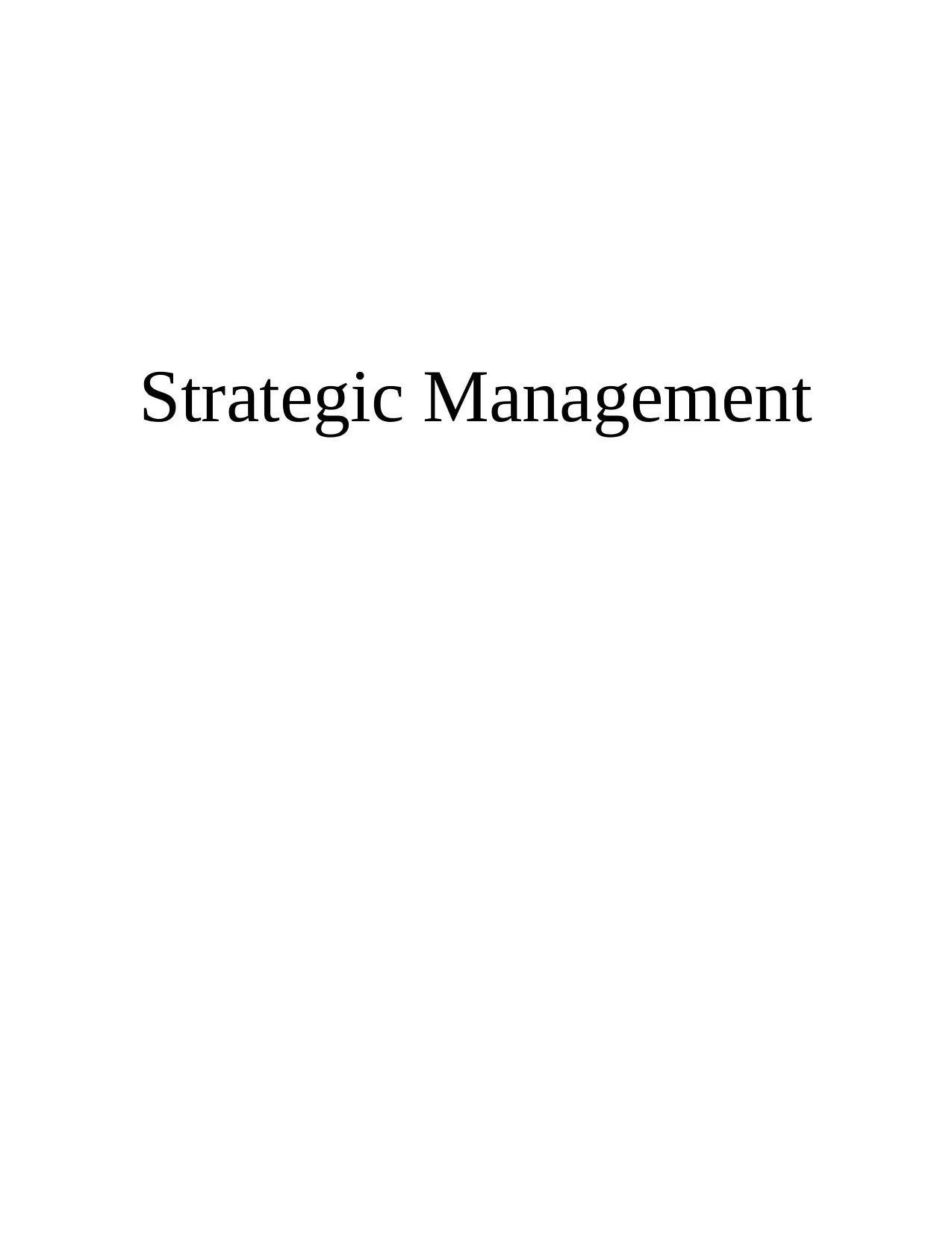
Strategic Management
Paraphrase This Document
Need a fresh take? Get an instant paraphrase of this document with our AI Paraphraser
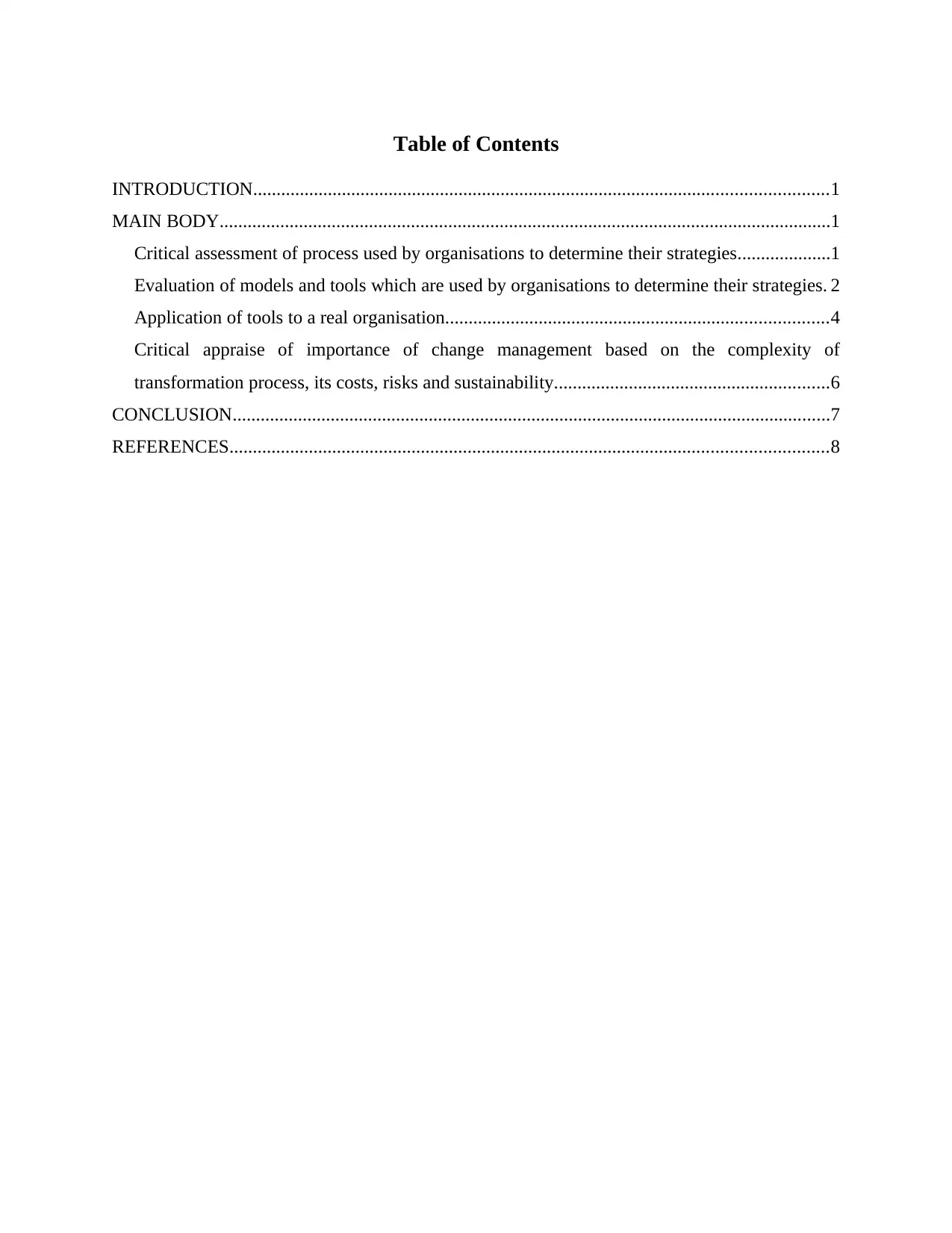
Table of Contents
INTRODUCTION...........................................................................................................................1
MAIN BODY...................................................................................................................................1
Critical assessment of process used by organisations to determine their strategies....................1
Evaluation of models and tools which are used by organisations to determine their strategies. 2
Application of tools to a real organisation..................................................................................4
Critical appraise of importance of change management based on the complexity of
transformation process, its costs, risks and sustainability...........................................................6
CONCLUSION................................................................................................................................7
REFERENCES................................................................................................................................8
INTRODUCTION...........................................................................................................................1
MAIN BODY...................................................................................................................................1
Critical assessment of process used by organisations to determine their strategies....................1
Evaluation of models and tools which are used by organisations to determine their strategies. 2
Application of tools to a real organisation..................................................................................4
Critical appraise of importance of change management based on the complexity of
transformation process, its costs, risks and sustainability...........................................................6
CONCLUSION................................................................................................................................7
REFERENCES................................................................................................................................8

INTRODUCTION
Strategic Management can be defined as the control over the resources of organisation
which helps management divisions in achievement of their future goals and objectives. It
includes setting objectives, analysation of competitive environment, analysation of internal
activities, evaluation of strategies and ensure that managers are managing strategies (Aithal and
Acharya, 2016). The company chosen for this project report is Tesco Plc which was founded by
Jack Cohen, being operated in 11 countries with supermarket, hypermarkets, superstores and
convenience shops. The report focuses on the assessment of the process which is used by
organisations for determination of their strategies. Evaluation of models and tools which are used
by companies and its application is focused with the importance of change management which is
based on complexity of transformation process, its costs, risks and sustainability.
MAIN BODY
Critical assessment of process used by organisations to determine their strategies.
With the help of strategic planning process organisations can determine strategies which
can help in achievement of organisational goals. It is framework which systematically performs
strategic plans in a company through curtain steps. The managers are responsible for creating
complete strategies and derives how they will be implemented for success of organisation. The
ways the mangers create and then realize them may differ depending upon companies
organisation's culture, leadership style and experience of firm (Bianchi, Mingo and Fernandez,
2019). The following are the steps of strategic planning process which can be used by
organisations:
Determination of strategic position- For starting strategic planning company first needs
to determine where it is, where it needs to go and how it will get there. Management of
company needs to get right stakeholders from the start which needs to consider both
internal and external sources. Managers of company identify key of strategic issues by
discussing with the executive of company, pulling customer insights and collecting data
of industry and market. All these things help in getting clear image of the customers in
market and the position of company in competitive environment.
Prioritization of objectives- Once the mangers identifies current position in its industry
it is operating, the next step is to determine objectives which would ultimately help in
1
Strategic Management can be defined as the control over the resources of organisation
which helps management divisions in achievement of their future goals and objectives. It
includes setting objectives, analysation of competitive environment, analysation of internal
activities, evaluation of strategies and ensure that managers are managing strategies (Aithal and
Acharya, 2016). The company chosen for this project report is Tesco Plc which was founded by
Jack Cohen, being operated in 11 countries with supermarket, hypermarkets, superstores and
convenience shops. The report focuses on the assessment of the process which is used by
organisations for determination of their strategies. Evaluation of models and tools which are used
by companies and its application is focused with the importance of change management which is
based on complexity of transformation process, its costs, risks and sustainability.
MAIN BODY
Critical assessment of process used by organisations to determine their strategies.
With the help of strategic planning process organisations can determine strategies which
can help in achievement of organisational goals. It is framework which systematically performs
strategic plans in a company through curtain steps. The managers are responsible for creating
complete strategies and derives how they will be implemented for success of organisation. The
ways the mangers create and then realize them may differ depending upon companies
organisation's culture, leadership style and experience of firm (Bianchi, Mingo and Fernandez,
2019). The following are the steps of strategic planning process which can be used by
organisations:
Determination of strategic position- For starting strategic planning company first needs
to determine where it is, where it needs to go and how it will get there. Management of
company needs to get right stakeholders from the start which needs to consider both
internal and external sources. Managers of company identify key of strategic issues by
discussing with the executive of company, pulling customer insights and collecting data
of industry and market. All these things help in getting clear image of the customers in
market and the position of company in competitive environment.
Prioritization of objectives- Once the mangers identifies current position in its industry
it is operating, the next step is to determine objectives which would ultimately help in
1
⊘ This is a preview!⊘
Do you want full access?
Subscribe today to unlock all pages.

Trusted by 1+ million students worldwide
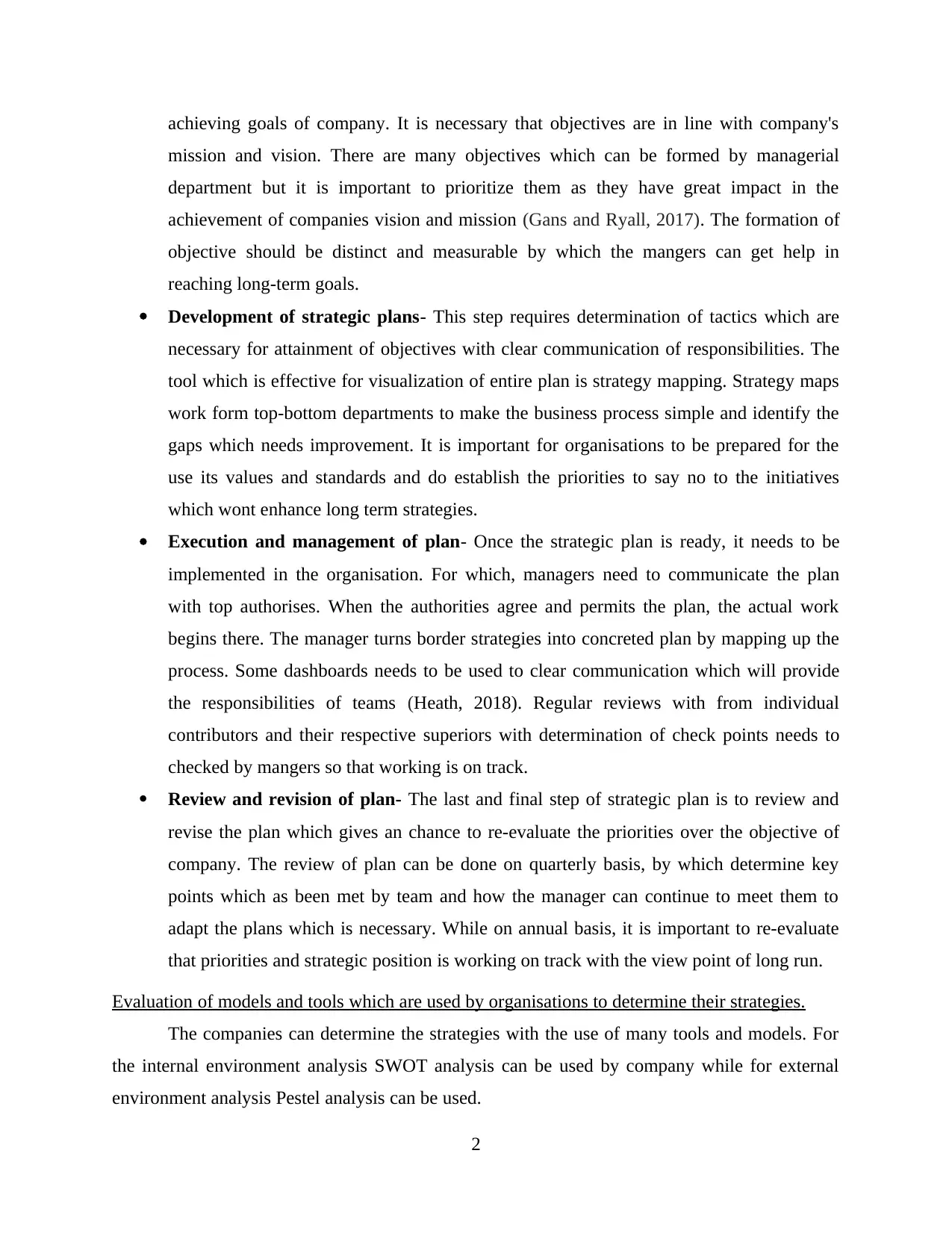
achieving goals of company. It is necessary that objectives are in line with company's
mission and vision. There are many objectives which can be formed by managerial
department but it is important to prioritize them as they have great impact in the
achievement of companies vision and mission (Gans and Ryall, 2017). The formation of
objective should be distinct and measurable by which the mangers can get help in
reaching long-term goals.
Development of strategic plans- This step requires determination of tactics which are
necessary for attainment of objectives with clear communication of responsibilities. The
tool which is effective for visualization of entire plan is strategy mapping. Strategy maps
work form top-bottom departments to make the business process simple and identify the
gaps which needs improvement. It is important for organisations to be prepared for the
use its values and standards and do establish the priorities to say no to the initiatives
which wont enhance long term strategies.
Execution and management of plan- Once the strategic plan is ready, it needs to be
implemented in the organisation. For which, managers need to communicate the plan
with top authorises. When the authorities agree and permits the plan, the actual work
begins there. The manager turns border strategies into concreted plan by mapping up the
process. Some dashboards needs to be used to clear communication which will provide
the responsibilities of teams (Heath, 2018). Regular reviews with from individual
contributors and their respective superiors with determination of check points needs to
checked by mangers so that working is on track.
Review and revision of plan- The last and final step of strategic plan is to review and
revise the plan which gives an chance to re-evaluate the priorities over the objective of
company. The review of plan can be done on quarterly basis, by which determine key
points which as been met by team and how the manager can continue to meet them to
adapt the plans which is necessary. While on annual basis, it is important to re-evaluate
that priorities and strategic position is working on track with the view point of long run.
Evaluation of models and tools which are used by organisations to determine their strategies.
The companies can determine the strategies with the use of many tools and models. For
the internal environment analysis SWOT analysis can be used by company while for external
environment analysis Pestel analysis can be used.
2
mission and vision. There are many objectives which can be formed by managerial
department but it is important to prioritize them as they have great impact in the
achievement of companies vision and mission (Gans and Ryall, 2017). The formation of
objective should be distinct and measurable by which the mangers can get help in
reaching long-term goals.
Development of strategic plans- This step requires determination of tactics which are
necessary for attainment of objectives with clear communication of responsibilities. The
tool which is effective for visualization of entire plan is strategy mapping. Strategy maps
work form top-bottom departments to make the business process simple and identify the
gaps which needs improvement. It is important for organisations to be prepared for the
use its values and standards and do establish the priorities to say no to the initiatives
which wont enhance long term strategies.
Execution and management of plan- Once the strategic plan is ready, it needs to be
implemented in the organisation. For which, managers need to communicate the plan
with top authorises. When the authorities agree and permits the plan, the actual work
begins there. The manager turns border strategies into concreted plan by mapping up the
process. Some dashboards needs to be used to clear communication which will provide
the responsibilities of teams (Heath, 2018). Regular reviews with from individual
contributors and their respective superiors with determination of check points needs to
checked by mangers so that working is on track.
Review and revision of plan- The last and final step of strategic plan is to review and
revise the plan which gives an chance to re-evaluate the priorities over the objective of
company. The review of plan can be done on quarterly basis, by which determine key
points which as been met by team and how the manager can continue to meet them to
adapt the plans which is necessary. While on annual basis, it is important to re-evaluate
that priorities and strategic position is working on track with the view point of long run.
Evaluation of models and tools which are used by organisations to determine their strategies.
The companies can determine the strategies with the use of many tools and models. For
the internal environment analysis SWOT analysis can be used by company while for external
environment analysis Pestel analysis can be used.
2
Paraphrase This Document
Need a fresh take? Get an instant paraphrase of this document with our AI Paraphraser
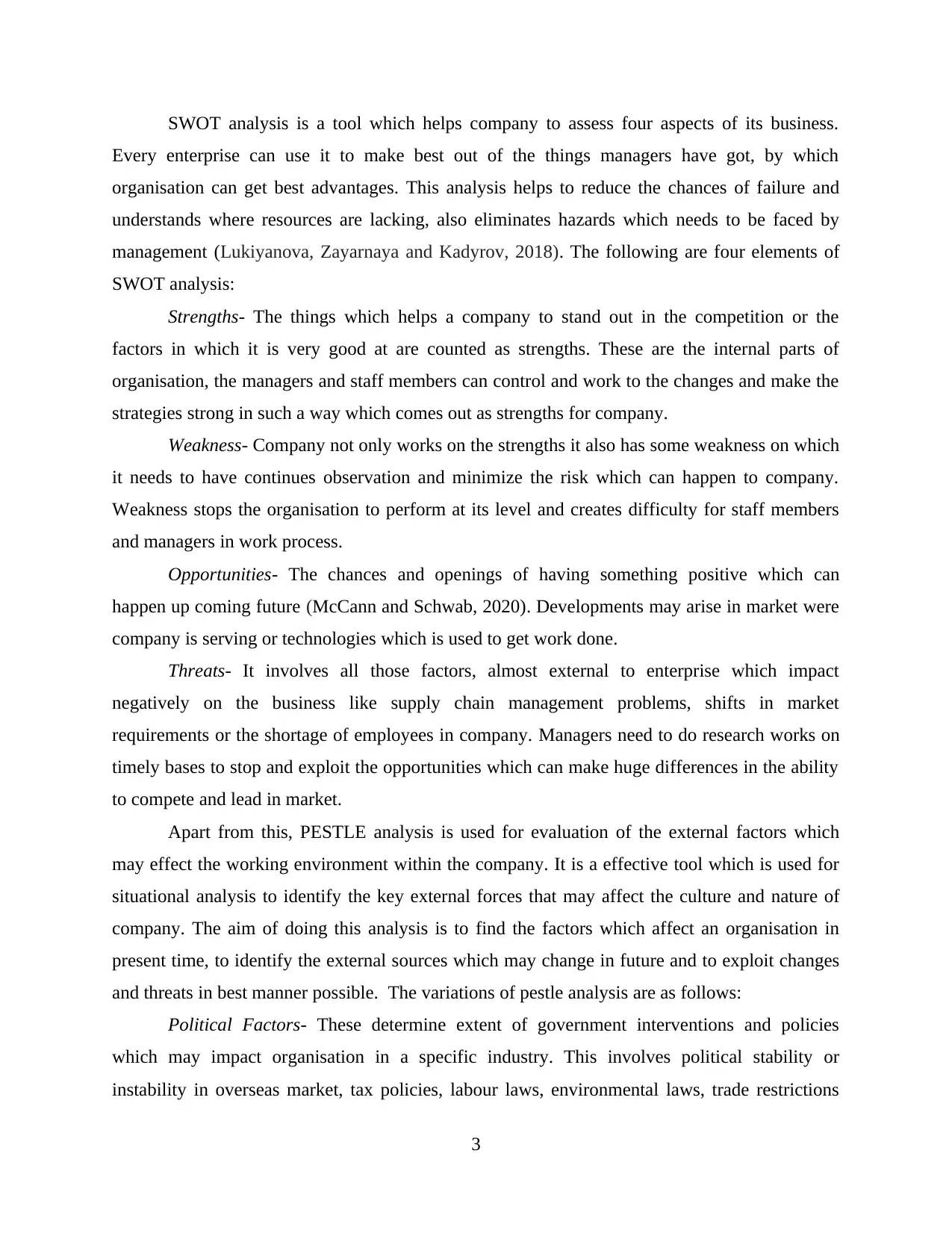
SWOT analysis is a tool which helps company to assess four aspects of its business.
Every enterprise can use it to make best out of the things managers have got, by which
organisation can get best advantages. This analysis helps to reduce the chances of failure and
understands where resources are lacking, also eliminates hazards which needs to be faced by
management (Lukiyanova, Zayarnaya and Kadyrov, 2018). The following are four elements of
SWOT analysis:
Strengths- The things which helps a company to stand out in the competition or the
factors in which it is very good at are counted as strengths. These are the internal parts of
organisation, the managers and staff members can control and work to the changes and make the
strategies strong in such a way which comes out as strengths for company.
Weakness- Company not only works on the strengths it also has some weakness on which
it needs to have continues observation and minimize the risk which can happen to company.
Weakness stops the organisation to perform at its level and creates difficulty for staff members
and managers in work process.
Opportunities- The chances and openings of having something positive which can
happen up coming future (McCann and Schwab, 2020). Developments may arise in market were
company is serving or technologies which is used to get work done.
Threats- It involves all those factors, almost external to enterprise which impact
negatively on the business like supply chain management problems, shifts in market
requirements or the shortage of employees in company. Managers need to do research works on
timely bases to stop and exploit the opportunities which can make huge differences in the ability
to compete and lead in market.
Apart from this, PESTLE analysis is used for evaluation of the external factors which
may effect the working environment within the company. It is a effective tool which is used for
situational analysis to identify the key external forces that may affect the culture and nature of
company. The aim of doing this analysis is to find the factors which affect an organisation in
present time, to identify the external sources which may change in future and to exploit changes
and threats in best manner possible. The variations of pestle analysis are as follows:
Political Factors- These determine extent of government interventions and policies
which may impact organisation in a specific industry. This involves political stability or
instability in overseas market, tax policies, labour laws, environmental laws, trade restrictions
3
Every enterprise can use it to make best out of the things managers have got, by which
organisation can get best advantages. This analysis helps to reduce the chances of failure and
understands where resources are lacking, also eliminates hazards which needs to be faced by
management (Lukiyanova, Zayarnaya and Kadyrov, 2018). The following are four elements of
SWOT analysis:
Strengths- The things which helps a company to stand out in the competition or the
factors in which it is very good at are counted as strengths. These are the internal parts of
organisation, the managers and staff members can control and work to the changes and make the
strategies strong in such a way which comes out as strengths for company.
Weakness- Company not only works on the strengths it also has some weakness on which
it needs to have continues observation and minimize the risk which can happen to company.
Weakness stops the organisation to perform at its level and creates difficulty for staff members
and managers in work process.
Opportunities- The chances and openings of having something positive which can
happen up coming future (McCann and Schwab, 2020). Developments may arise in market were
company is serving or technologies which is used to get work done.
Threats- It involves all those factors, almost external to enterprise which impact
negatively on the business like supply chain management problems, shifts in market
requirements or the shortage of employees in company. Managers need to do research works on
timely bases to stop and exploit the opportunities which can make huge differences in the ability
to compete and lead in market.
Apart from this, PESTLE analysis is used for evaluation of the external factors which
may effect the working environment within the company. It is a effective tool which is used for
situational analysis to identify the key external forces that may affect the culture and nature of
company. The aim of doing this analysis is to find the factors which affect an organisation in
present time, to identify the external sources which may change in future and to exploit changes
and threats in best manner possible. The variations of pestle analysis are as follows:
Political Factors- These determine extent of government interventions and policies
which may impact organisation in a specific industry. This involves political stability or
instability in overseas market, tax policies, labour laws, environmental laws, trade restrictions
3
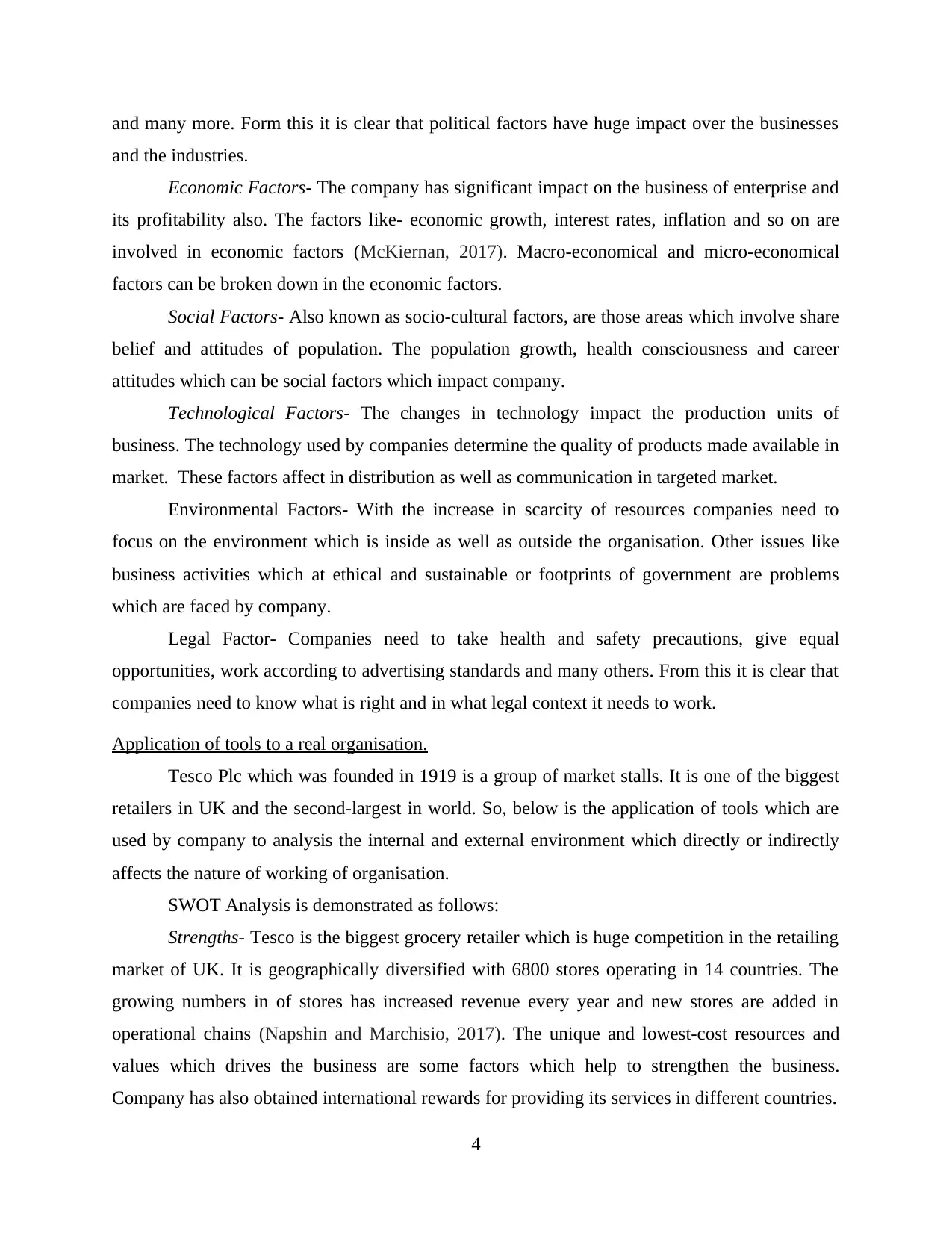
and many more. Form this it is clear that political factors have huge impact over the businesses
and the industries.
Economic Factors- The company has significant impact on the business of enterprise and
its profitability also. The factors like- economic growth, interest rates, inflation and so on are
involved in economic factors (McKiernan, 2017). Macro-economical and micro-economical
factors can be broken down in the economic factors.
Social Factors- Also known as socio-cultural factors, are those areas which involve share
belief and attitudes of population. The population growth, health consciousness and career
attitudes which can be social factors which impact company.
Technological Factors- The changes in technology impact the production units of
business. The technology used by companies determine the quality of products made available in
market. These factors affect in distribution as well as communication in targeted market.
Environmental Factors- With the increase in scarcity of resources companies need to
focus on the environment which is inside as well as outside the organisation. Other issues like
business activities which at ethical and sustainable or footprints of government are problems
which are faced by company.
Legal Factor- Companies need to take health and safety precautions, give equal
opportunities, work according to advertising standards and many others. From this it is clear that
companies need to know what is right and in what legal context it needs to work.
Application of tools to a real organisation.
Tesco Plc which was founded in 1919 is a group of market stalls. It is one of the biggest
retailers in UK and the second-largest in world. So, below is the application of tools which are
used by company to analysis the internal and external environment which directly or indirectly
affects the nature of working of organisation.
SWOT Analysis is demonstrated as follows:
Strengths- Tesco is the biggest grocery retailer which is huge competition in the retailing
market of UK. It is geographically diversified with 6800 stores operating in 14 countries. The
growing numbers in of stores has increased revenue every year and new stores are added in
operational chains (Napshin and Marchisio, 2017). The unique and lowest-cost resources and
values which drives the business are some factors which help to strengthen the business.
Company has also obtained international rewards for providing its services in different countries.
4
and the industries.
Economic Factors- The company has significant impact on the business of enterprise and
its profitability also. The factors like- economic growth, interest rates, inflation and so on are
involved in economic factors (McKiernan, 2017). Macro-economical and micro-economical
factors can be broken down in the economic factors.
Social Factors- Also known as socio-cultural factors, are those areas which involve share
belief and attitudes of population. The population growth, health consciousness and career
attitudes which can be social factors which impact company.
Technological Factors- The changes in technology impact the production units of
business. The technology used by companies determine the quality of products made available in
market. These factors affect in distribution as well as communication in targeted market.
Environmental Factors- With the increase in scarcity of resources companies need to
focus on the environment which is inside as well as outside the organisation. Other issues like
business activities which at ethical and sustainable or footprints of government are problems
which are faced by company.
Legal Factor- Companies need to take health and safety precautions, give equal
opportunities, work according to advertising standards and many others. From this it is clear that
companies need to know what is right and in what legal context it needs to work.
Application of tools to a real organisation.
Tesco Plc which was founded in 1919 is a group of market stalls. It is one of the biggest
retailers in UK and the second-largest in world. So, below is the application of tools which are
used by company to analysis the internal and external environment which directly or indirectly
affects the nature of working of organisation.
SWOT Analysis is demonstrated as follows:
Strengths- Tesco is the biggest grocery retailer which is huge competition in the retailing
market of UK. It is geographically diversified with 6800 stores operating in 14 countries. The
growing numbers in of stores has increased revenue every year and new stores are added in
operational chains (Napshin and Marchisio, 2017). The unique and lowest-cost resources and
values which drives the business are some factors which help to strengthen the business.
Company has also obtained international rewards for providing its services in different countries.
4
⊘ This is a preview!⊘
Do you want full access?
Subscribe today to unlock all pages.

Trusted by 1+ million students worldwide
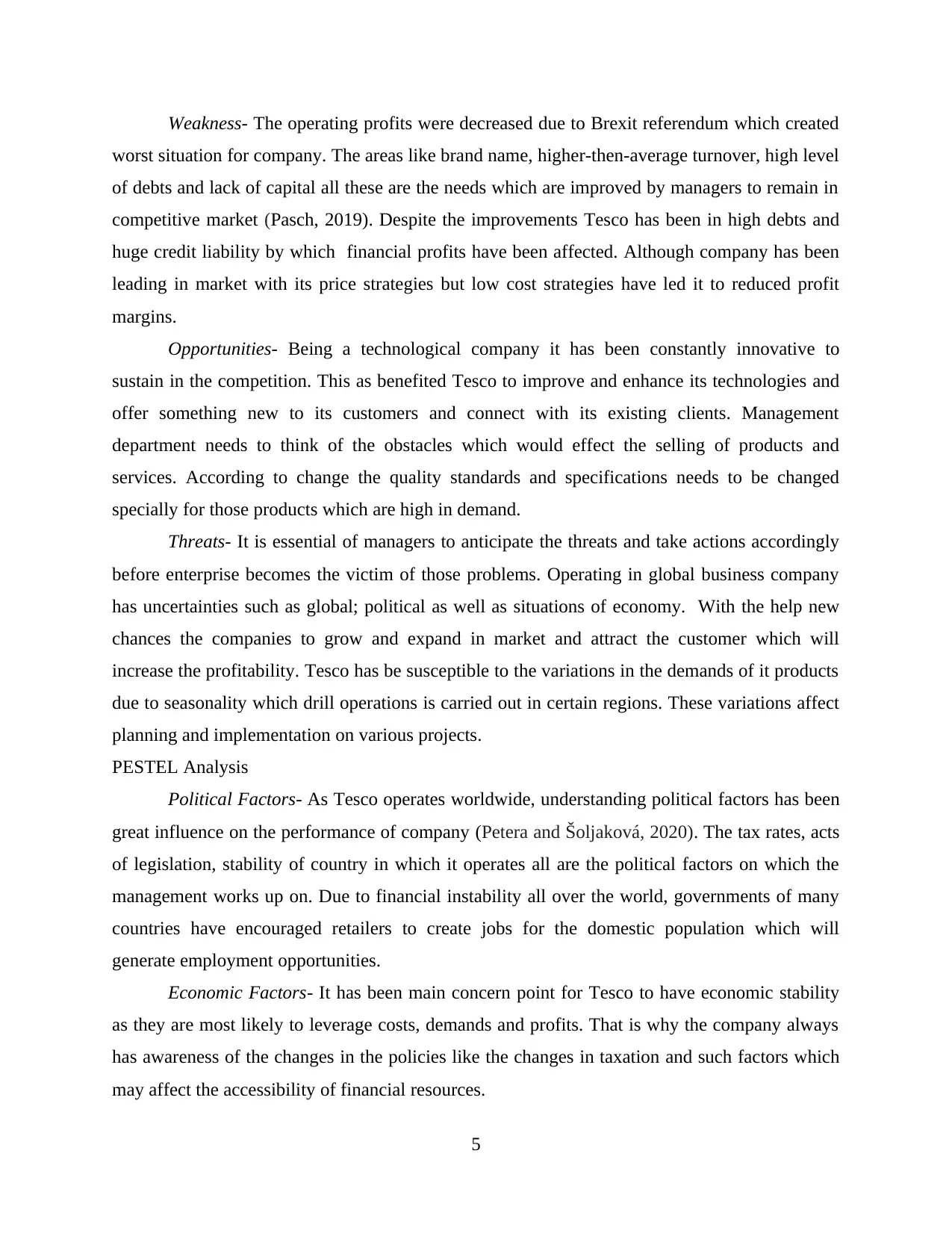
Weakness- The operating profits were decreased due to Brexit referendum which created
worst situation for company. The areas like brand name, higher-then-average turnover, high level
of debts and lack of capital all these are the needs which are improved by managers to remain in
competitive market (Pasch, 2019). Despite the improvements Tesco has been in high debts and
huge credit liability by which financial profits have been affected. Although company has been
leading in market with its price strategies but low cost strategies have led it to reduced profit
margins.
Opportunities- Being a technological company it has been constantly innovative to
sustain in the competition. This as benefited Tesco to improve and enhance its technologies and
offer something new to its customers and connect with its existing clients. Management
department needs to think of the obstacles which would effect the selling of products and
services. According to change the quality standards and specifications needs to be changed
specially for those products which are high in demand.
Threats- It is essential of managers to anticipate the threats and take actions accordingly
before enterprise becomes the victim of those problems. Operating in global business company
has uncertainties such as global; political as well as situations of economy. With the help new
chances the companies to grow and expand in market and attract the customer which will
increase the profitability. Tesco has be susceptible to the variations in the demands of it products
due to seasonality which drill operations is carried out in certain regions. These variations affect
planning and implementation on various projects.
PESTEL Analysis
Political Factors- As Tesco operates worldwide, understanding political factors has been
great influence on the performance of company (Petera and Šoljaková, 2020). The tax rates, acts
of legislation, stability of country in which it operates all are the political factors on which the
management works up on. Due to financial instability all over the world, governments of many
countries have encouraged retailers to create jobs for the domestic population which will
generate employment opportunities.
Economic Factors- It has been main concern point for Tesco to have economic stability
as they are most likely to leverage costs, demands and profits. That is why the company always
has awareness of the changes in the policies like the changes in taxation and such factors which
may affect the accessibility of financial resources.
5
worst situation for company. The areas like brand name, higher-then-average turnover, high level
of debts and lack of capital all these are the needs which are improved by managers to remain in
competitive market (Pasch, 2019). Despite the improvements Tesco has been in high debts and
huge credit liability by which financial profits have been affected. Although company has been
leading in market with its price strategies but low cost strategies have led it to reduced profit
margins.
Opportunities- Being a technological company it has been constantly innovative to
sustain in the competition. This as benefited Tesco to improve and enhance its technologies and
offer something new to its customers and connect with its existing clients. Management
department needs to think of the obstacles which would effect the selling of products and
services. According to change the quality standards and specifications needs to be changed
specially for those products which are high in demand.
Threats- It is essential of managers to anticipate the threats and take actions accordingly
before enterprise becomes the victim of those problems. Operating in global business company
has uncertainties such as global; political as well as situations of economy. With the help new
chances the companies to grow and expand in market and attract the customer which will
increase the profitability. Tesco has be susceptible to the variations in the demands of it products
due to seasonality which drill operations is carried out in certain regions. These variations affect
planning and implementation on various projects.
PESTEL Analysis
Political Factors- As Tesco operates worldwide, understanding political factors has been
great influence on the performance of company (Petera and Šoljaková, 2020). The tax rates, acts
of legislation, stability of country in which it operates all are the political factors on which the
management works up on. Due to financial instability all over the world, governments of many
countries have encouraged retailers to create jobs for the domestic population which will
generate employment opportunities.
Economic Factors- It has been main concern point for Tesco to have economic stability
as they are most likely to leverage costs, demands and profits. That is why the company always
has awareness of the changes in the policies like the changes in taxation and such factors which
may affect the accessibility of financial resources.
5
Paraphrase This Document
Need a fresh take? Get an instant paraphrase of this document with our AI Paraphraser
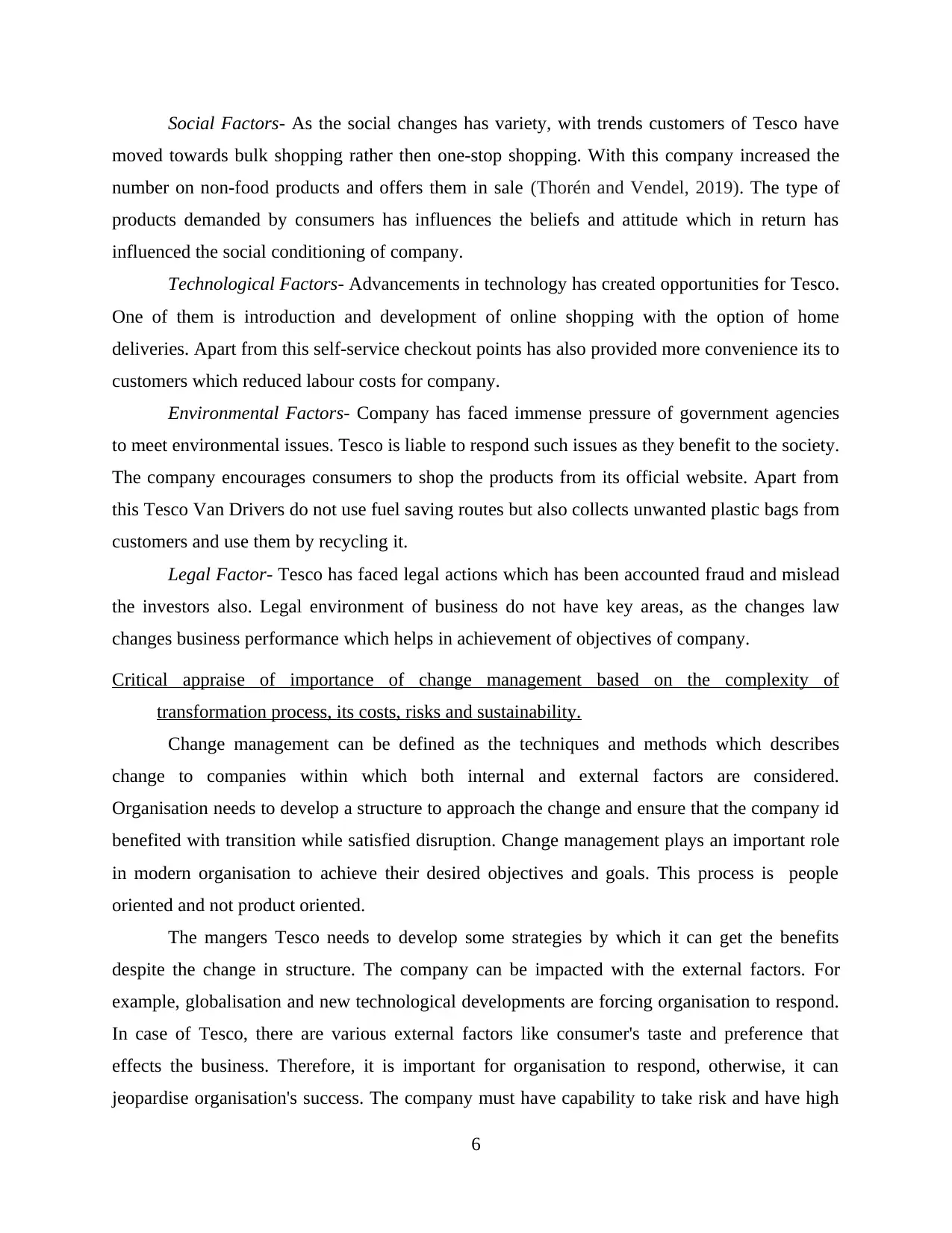
Social Factors- As the social changes has variety, with trends customers of Tesco have
moved towards bulk shopping rather then one-stop shopping. With this company increased the
number on non-food products and offers them in sale (Thorén and Vendel, 2019). The type of
products demanded by consumers has influences the beliefs and attitude which in return has
influenced the social conditioning of company.
Technological Factors- Advancements in technology has created opportunities for Tesco.
One of them is introduction and development of online shopping with the option of home
deliveries. Apart from this self-service checkout points has also provided more convenience its to
customers which reduced labour costs for company.
Environmental Factors- Company has faced immense pressure of government agencies
to meet environmental issues. Tesco is liable to respond such issues as they benefit to the society.
The company encourages consumers to shop the products from its official website. Apart from
this Tesco Van Drivers do not use fuel saving routes but also collects unwanted plastic bags from
customers and use them by recycling it.
Legal Factor- Tesco has faced legal actions which has been accounted fraud and mislead
the investors also. Legal environment of business do not have key areas, as the changes law
changes business performance which helps in achievement of objectives of company.
Critical appraise of importance of change management based on the complexity of
transformation process, its costs, risks and sustainability.
Change management can be defined as the techniques and methods which describes
change to companies within which both internal and external factors are considered.
Organisation needs to develop a structure to approach the change and ensure that the company id
benefited with transition while satisfied disruption. Change management plays an important role
in modern organisation to achieve their desired objectives and goals. This process is people
oriented and not product oriented.
The mangers Tesco needs to develop some strategies by which it can get the benefits
despite the change in structure. The company can be impacted with the external factors. For
example, globalisation and new technological developments are forcing organisation to respond.
In case of Tesco, there are various external factors like consumer's taste and preference that
effects the business. Therefore, it is important for organisation to respond, otherwise, it can
jeopardise organisation's success. The company must have capability to take risk and have high
6
moved towards bulk shopping rather then one-stop shopping. With this company increased the
number on non-food products and offers them in sale (Thorén and Vendel, 2019). The type of
products demanded by consumers has influences the beliefs and attitude which in return has
influenced the social conditioning of company.
Technological Factors- Advancements in technology has created opportunities for Tesco.
One of them is introduction and development of online shopping with the option of home
deliveries. Apart from this self-service checkout points has also provided more convenience its to
customers which reduced labour costs for company.
Environmental Factors- Company has faced immense pressure of government agencies
to meet environmental issues. Tesco is liable to respond such issues as they benefit to the society.
The company encourages consumers to shop the products from its official website. Apart from
this Tesco Van Drivers do not use fuel saving routes but also collects unwanted plastic bags from
customers and use them by recycling it.
Legal Factor- Tesco has faced legal actions which has been accounted fraud and mislead
the investors also. Legal environment of business do not have key areas, as the changes law
changes business performance which helps in achievement of objectives of company.
Critical appraise of importance of change management based on the complexity of
transformation process, its costs, risks and sustainability.
Change management can be defined as the techniques and methods which describes
change to companies within which both internal and external factors are considered.
Organisation needs to develop a structure to approach the change and ensure that the company id
benefited with transition while satisfied disruption. Change management plays an important role
in modern organisation to achieve their desired objectives and goals. This process is people
oriented and not product oriented.
The mangers Tesco needs to develop some strategies by which it can get the benefits
despite the change in structure. The company can be impacted with the external factors. For
example, globalisation and new technological developments are forcing organisation to respond.
In case of Tesco, there are various external factors like consumer's taste and preference that
effects the business. Therefore, it is important for organisation to respond, otherwise, it can
jeopardise organisation's success. The company must have capability to take risk and have high
6
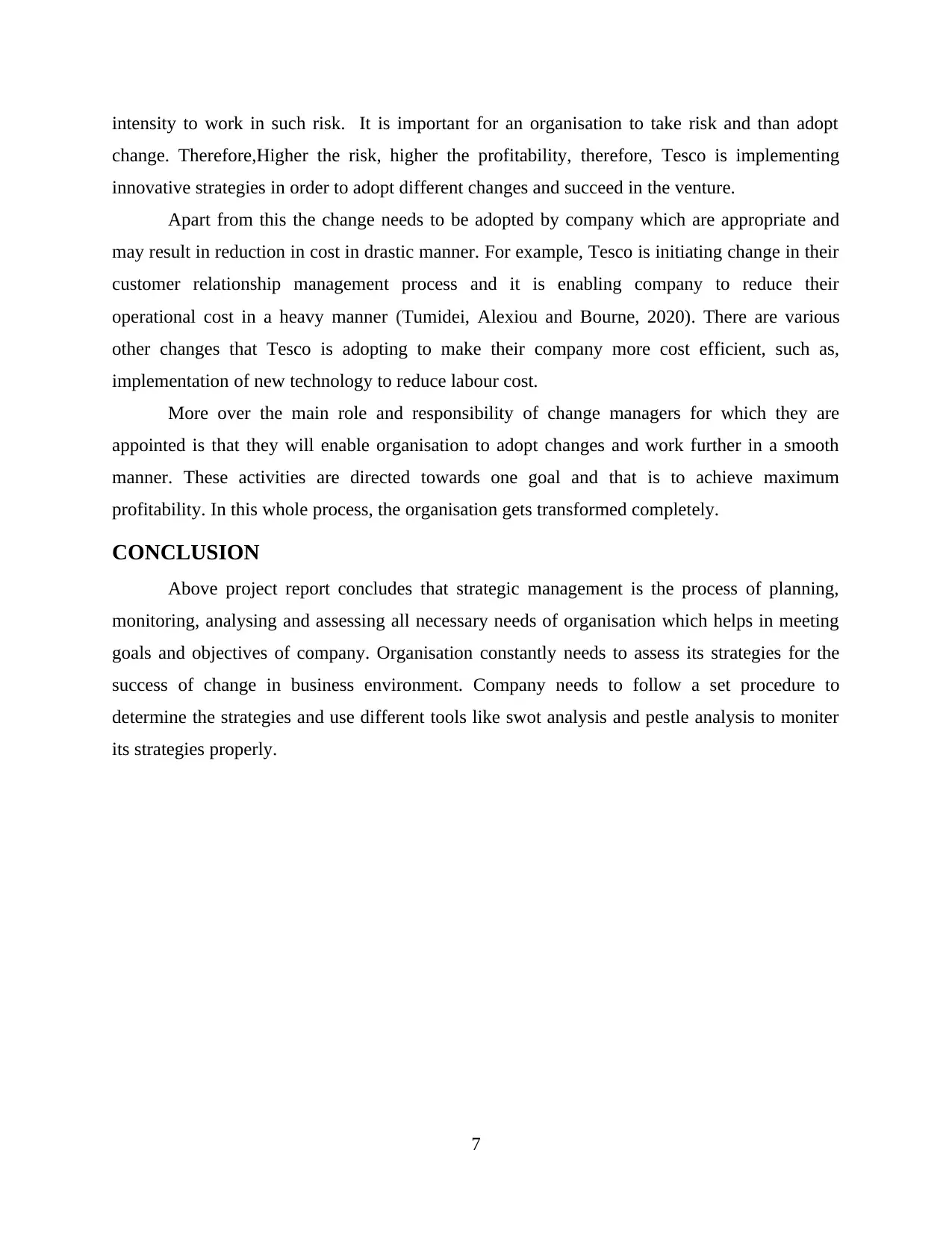
intensity to work in such risk. It is important for an organisation to take risk and than adopt
change. Therefore,Higher the risk, higher the profitability, therefore, Tesco is implementing
innovative strategies in order to adopt different changes and succeed in the venture.
Apart from this the change needs to be adopted by company which are appropriate and
may result in reduction in cost in drastic manner. For example, Tesco is initiating change in their
customer relationship management process and it is enabling company to reduce their
operational cost in a heavy manner (Tumidei, Alexiou and Bourne, 2020). There are various
other changes that Tesco is adopting to make their company more cost efficient, such as,
implementation of new technology to reduce labour cost.
More over the main role and responsibility of change managers for which they are
appointed is that they will enable organisation to adopt changes and work further in a smooth
manner. These activities are directed towards one goal and that is to achieve maximum
profitability. In this whole process, the organisation gets transformed completely.
CONCLUSION
Above project report concludes that strategic management is the process of planning,
monitoring, analysing and assessing all necessary needs of organisation which helps in meeting
goals and objectives of company. Organisation constantly needs to assess its strategies for the
success of change in business environment. Company needs to follow a set procedure to
determine the strategies and use different tools like swot analysis and pestle analysis to moniter
its strategies properly.
7
change. Therefore,Higher the risk, higher the profitability, therefore, Tesco is implementing
innovative strategies in order to adopt different changes and succeed in the venture.
Apart from this the change needs to be adopted by company which are appropriate and
may result in reduction in cost in drastic manner. For example, Tesco is initiating change in their
customer relationship management process and it is enabling company to reduce their
operational cost in a heavy manner (Tumidei, Alexiou and Bourne, 2020). There are various
other changes that Tesco is adopting to make their company more cost efficient, such as,
implementation of new technology to reduce labour cost.
More over the main role and responsibility of change managers for which they are
appointed is that they will enable organisation to adopt changes and work further in a smooth
manner. These activities are directed towards one goal and that is to achieve maximum
profitability. In this whole process, the organisation gets transformed completely.
CONCLUSION
Above project report concludes that strategic management is the process of planning,
monitoring, analysing and assessing all necessary needs of organisation which helps in meeting
goals and objectives of company. Organisation constantly needs to assess its strategies for the
success of change in business environment. Company needs to follow a set procedure to
determine the strategies and use different tools like swot analysis and pestle analysis to moniter
its strategies properly.
7
⊘ This is a preview!⊘
Do you want full access?
Subscribe today to unlock all pages.

Trusted by 1+ million students worldwide
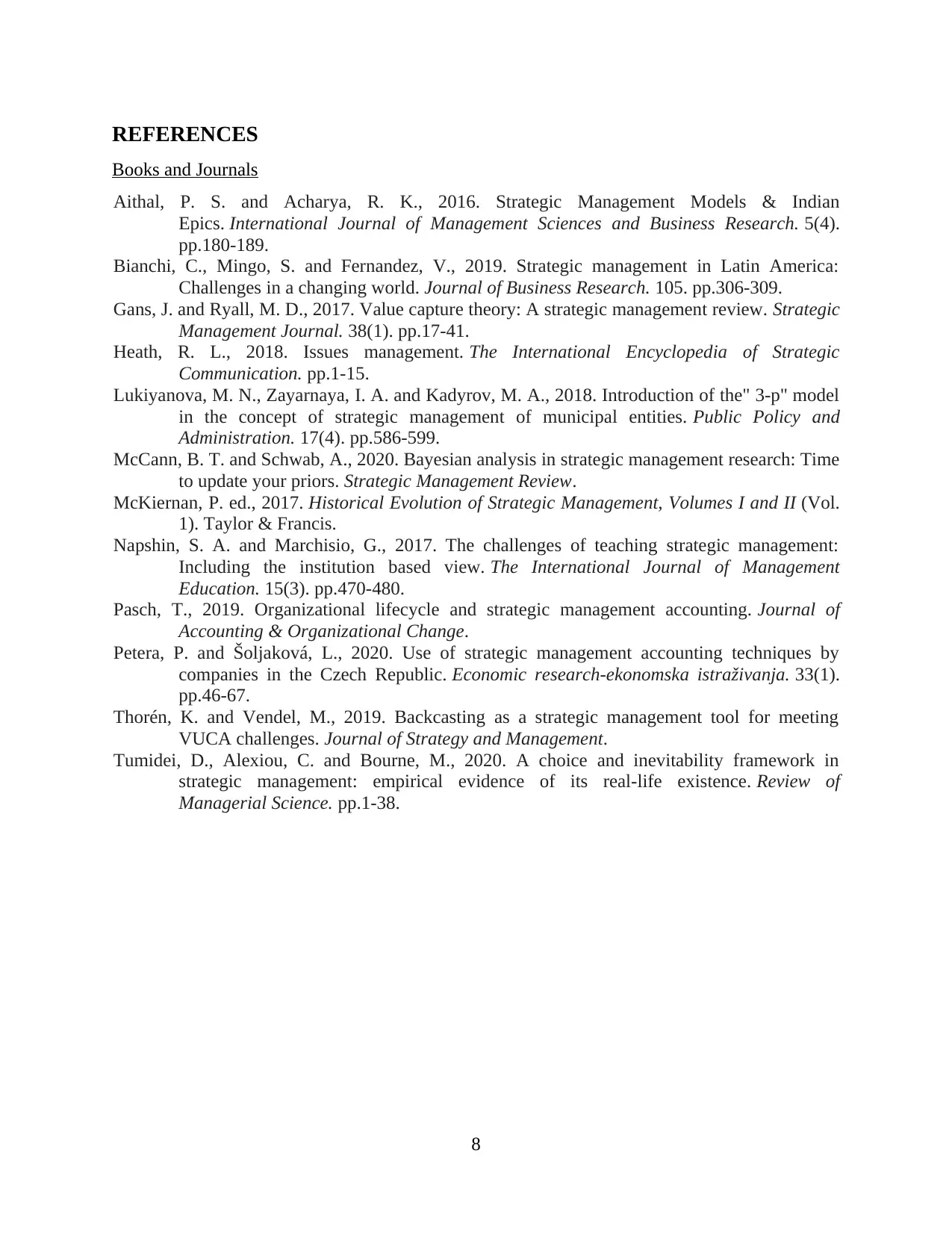
REFERENCES
Books and Journals
Aithal, P. S. and Acharya, R. K., 2016. Strategic Management Models & Indian
Epics. International Journal of Management Sciences and Business Research. 5(4).
pp.180-189.
Bianchi, C., Mingo, S. and Fernandez, V., 2019. Strategic management in Latin America:
Challenges in a changing world. Journal of Business Research. 105. pp.306-309.
Gans, J. and Ryall, M. D., 2017. Value capture theory: A strategic management review. Strategic
Management Journal. 38(1). pp.17-41.
Heath, R. L., 2018. Issues management. The International Encyclopedia of Strategic
Communication. pp.1-15.
Lukiyanova, M. N., Zayarnaya, I. A. and Kadyrov, M. A., 2018. Introduction of the" 3-p" model
in the concept of strategic management of municipal entities. Public Policy and
Administration. 17(4). pp.586-599.
McCann, B. T. and Schwab, A., 2020. Bayesian analysis in strategic management research: Time
to update your priors. Strategic Management Review.
McKiernan, P. ed., 2017. Historical Evolution of Strategic Management, Volumes I and II (Vol.
1). Taylor & Francis.
Napshin, S. A. and Marchisio, G., 2017. The challenges of teaching strategic management:
Including the institution based view. The International Journal of Management
Education. 15(3). pp.470-480.
Pasch, T., 2019. Organizational lifecycle and strategic management accounting. Journal of
Accounting & Organizational Change.
Petera, P. and Šoljaková, L., 2020. Use of strategic management accounting techniques by
companies in the Czech Republic. Economic research-ekonomska istraživanja. 33(1).
pp.46-67.
Thorén, K. and Vendel, M., 2019. Backcasting as a strategic management tool for meeting
VUCA challenges. Journal of Strategy and Management.
Tumidei, D., Alexiou, C. and Bourne, M., 2020. A choice and inevitability framework in
strategic management: empirical evidence of its real-life existence. Review of
Managerial Science. pp.1-38.
8
Books and Journals
Aithal, P. S. and Acharya, R. K., 2016. Strategic Management Models & Indian
Epics. International Journal of Management Sciences and Business Research. 5(4).
pp.180-189.
Bianchi, C., Mingo, S. and Fernandez, V., 2019. Strategic management in Latin America:
Challenges in a changing world. Journal of Business Research. 105. pp.306-309.
Gans, J. and Ryall, M. D., 2017. Value capture theory: A strategic management review. Strategic
Management Journal. 38(1). pp.17-41.
Heath, R. L., 2018. Issues management. The International Encyclopedia of Strategic
Communication. pp.1-15.
Lukiyanova, M. N., Zayarnaya, I. A. and Kadyrov, M. A., 2018. Introduction of the" 3-p" model
in the concept of strategic management of municipal entities. Public Policy and
Administration. 17(4). pp.586-599.
McCann, B. T. and Schwab, A., 2020. Bayesian analysis in strategic management research: Time
to update your priors. Strategic Management Review.
McKiernan, P. ed., 2017. Historical Evolution of Strategic Management, Volumes I and II (Vol.
1). Taylor & Francis.
Napshin, S. A. and Marchisio, G., 2017. The challenges of teaching strategic management:
Including the institution based view. The International Journal of Management
Education. 15(3). pp.470-480.
Pasch, T., 2019. Organizational lifecycle and strategic management accounting. Journal of
Accounting & Organizational Change.
Petera, P. and Šoljaková, L., 2020. Use of strategic management accounting techniques by
companies in the Czech Republic. Economic research-ekonomska istraživanja. 33(1).
pp.46-67.
Thorén, K. and Vendel, M., 2019. Backcasting as a strategic management tool for meeting
VUCA challenges. Journal of Strategy and Management.
Tumidei, D., Alexiou, C. and Bourne, M., 2020. A choice and inevitability framework in
strategic management: empirical evidence of its real-life existence. Review of
Managerial Science. pp.1-38.
8
1 out of 10
Related Documents
Your All-in-One AI-Powered Toolkit for Academic Success.
+13062052269
info@desklib.com
Available 24*7 on WhatsApp / Email
![[object Object]](/_next/static/media/star-bottom.7253800d.svg)
Unlock your academic potential
Copyright © 2020–2025 A2Z Services. All Rights Reserved. Developed and managed by ZUCOL.



